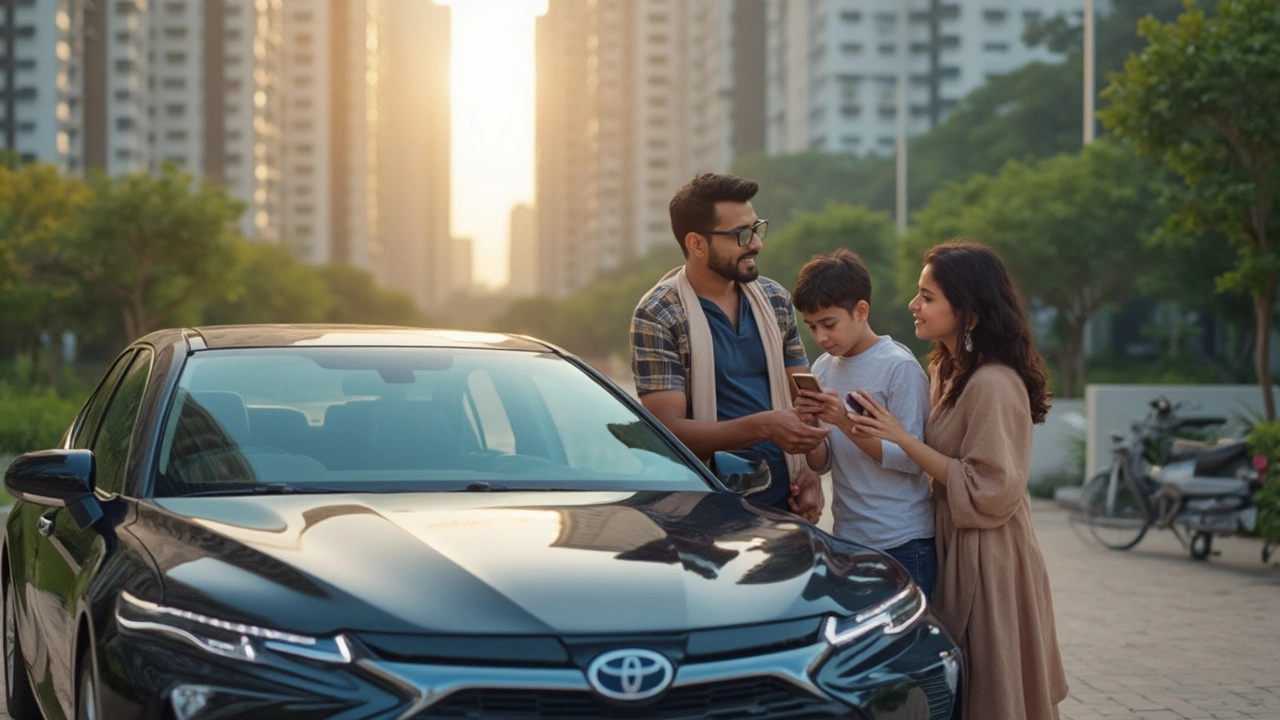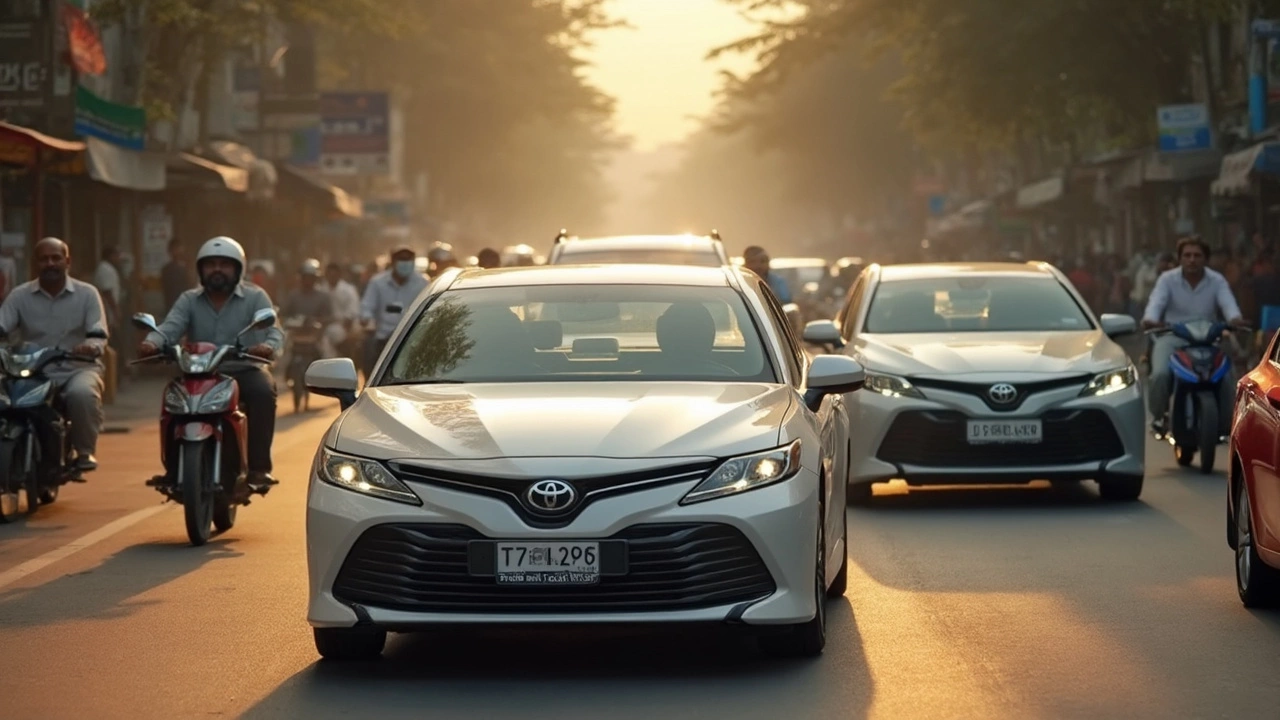There’s something about spotting a Toyota Camry in India—it turns heads, even if nobody admits it. Why? It’s not the cheapest option, nor does it scream for attention like an SUV. But there’s a solid reason you see so many Camrys rolling quietly in business parks, outside schools, even at airport drop-offs.
The main draw is simple: this car nails reliability. Indian buyers, especially in big cities, don’t want surprises from their ride, and the Camry is basically the gold standard for “no-nonsense.” Repairs are rare, parts are everywhere, and mechanics know their way around it. For families and business folks, that’s peace of mind money can’t buy.
But it’s not just about not breaking down. There’s the hybrid badge. Petrol prices feel like they’re climbing every week, so a hybrid that doesn’t nag you for fuel every other day is a godsend, especially if you do a lot of driving within city limits. Owners talk about how they fill up way less than their neighbours and still get all the perks of a comfy, roomy sedan.
- Why Camry Has a Loyal Fanbase
- The Hybrid Advantage and Running Costs
- How Camry Competes in Status and Comfort
- Smart Buying Tips for Indian Roads
Why Camry Has a Loyal Fanbase
The Camry isn’t just a car in India; for a lot of folks, it’s a no-brainer. One big reason is how reliable it is. Toyota’s known for building cars that last, and the Camry sits right at the top with the reputation for hardly needing any trip to the garage, even after years on the road. Professional drivers, top executives, and even families trust it because it just works. It’s common to see owners keep their Camrys for over a decade, racking up mileage with barely a hiccup.
There’s also comfort in knowing that spares and service are easy to find. Toyota’s network in India is huge, and that makes owning a Camry less stressful if something does go wrong. You’re never scrambling for expensive rare parts or specialist workshops.
Another thing: the Camry pulls off luxury without the drama. You get plush seats, smooth rides, and a super quiet cabin but none of the mechanical issues people sometimes complain about in European cars. Even after years under the harsh Indian sun and bumpy city roads, it keeps its cool (both literally—the AC is famous for being a chiller—and figuratively, with a suspension that soaks up potholes).
Resale value is another piece of the puzzle. Camrys tend to keep their value better than a lot of other sedans, so owners aren’t scared of losing a ton when it’s time to sell. The hybrid variant, especially launched in 2015, made a huge splash among urban buyers who suddenly wanted a sedan that felt fancy yet didn’t cost a bomb to run every month.
What seals the deal for the loyal crowd is the sense of smart buying. The Camry gives owners a blend of peace of mind, long-term savings, and just enough luxury to feel like an upgrade every time you sit in it, all without standing out too much or dealing with flashy car headaches.
The Hybrid Advantage and Running Costs
When it comes to fuel savings, the Camry hybrid doesn’t mess around. It’s one of the first big sedans in India that brings practical hybrid tech to the middle-class and business car scene. This means you get both a petrol engine and an electric motor working together—so the car switches to electric in heavy traffic or low-speed city driving, cutting down fuel use a lot. You really feel it during those bumper-to-bumper office commutes.
Just check out the numbers. The Camry hybrid claims a fuel efficiency close to 19.1 km/l (as per ARAI test results), while big petrol-only sedans usually struggle to get past 12-13 km/l in real city conditions. With current petrol prices easily crossing ₹100 per litre in most Indian cities, that saving keeps your wallet happier month after month.
Here’s a quick comparison:
| Car Model | Type | Claimed Mileage (km/l) | Average Monthly Fuel Cost (₹/1000km) |
|---|---|---|---|
| Toyota Camry Hybrid | Hybrid | 19.1 | ~₹5,250 |
| Skoda Superb | Petrol | 15.1 | ~₹6,650 |
| Honda Accord Hybrid | Hybrid | 23.1 | ~₹4,340 |
| Hyundai Sonata | Petrol | 13.0 | ~₹7,730 |
Don’t forget about service costs. Hybrids sometimes get a bad rap for expensive maintenance, but with the Camry, Toyota’s service network makes routine checks easy. Barring the drive battery (which comes with a warranty for as much as 8 years), most fixes cost about the same as the petrol-only versions. And let’s be honest, most folks rarely have big problems as long as they’re doing the regular services.
If you plan to keep the car for at least 5-7 years (which is pretty common in India), the savings on fuel and lower repairs add up. It’s not just about bragging rights or new tech. It’s just plain math. When you crunch the numbers, the Camry's hybrid edge makes it a smart bet for anyone tired of wallet-busting fuel bills and surprise workshop visits. For the modern Indian, it’s actually a pretty practical choice.

How Camry Competes in Status and Comfort
In India, driving a Camry says a lot about where you stand. It’s an unspoken badge of seniority, whether you’re picking up clients, dropping kids at school, or showing up to a family function. The Toyota logo alone holds weight, but the Camry’s size and style place it just a notch below luxury brands—without pushing you into “showoff” territory.
Let’s get real. Most folks who consider a Camry aren’t comparing it with entry-level sedans—they’re wondering if they should stretch for an Audi A4 or a Mercedes C-Class. But the Camry delivers key perks that matter in the real world. For starters, its rear seat is nearly unbeatable for the price. Three adults can sit comfortably—something German rivals struggle with unless you pay a premium for upgrades.
- Dual-zone climate control is standard—no more backseat complaints in Chennai heat or Delhi winters.
- Sound insulation is top-notch, so honking and street noise won’t drive you mad in city traffic.
- It’s packed with rear-seat features: sun shades, ample legroom, and AC vents as default—no splurging for extra kits.
- Cushioned ride quality is great for older passengers and long rides, which is clutch on India’s unpredictable roads.
If you ask office drivers, they’ll tell you: their bosses usually prefer being driven in a Camry over most other non-luxury cars. There’s enough space to make calls, relax, or even sneak in a quick nap between meetings. One Mumbai business owner sums it up best:
"I can send the Camry to pick up any client—no one ever feels it’s a downgrade. It’s comfortable, silent, and looks premium without going overboard," says Vishal Jain, CEO of a financial services startup.
Another thing—owners don’t need to worry about high-maintenance drama. There isn’t a bunch of fancy electronics that might fail unexpectedly, but you still get basics like an 8-inch touchscreen, a respectable audio system, and safety features like seven airbags and stability control in the latest models. The end result? You get all the executive perks minus luxury headaches and, honestly, the running cost is way lower than most “status” cars.
Smart Buying Tips for Indian Roads
Planning to join the group of Indians driving Camrys? Good call, but don’t just walk into the dealership and sign the first form they shove at you. Here’s what you should keep in mind to get the best out of a Camry in India.
- Camry hybrids are worth every rupee for urban drives, especially in cities with bumper-to-bumper traffic. Toyota’s hybrid tech gives you over 20 km/l in real-world city driving. That’s better than most SUVs, and you’ll feel the savings after just a year or two.
- If you’re worried about ground clearance (thanks to speed breakers and potholes), relax. The Indian Camry sits higher than its global cousin—165 mm clearance does the job for most urban and highway stretches. Just slow down for those monster-sized speed bumps.
- Servicing is not a hassle. Toyota’s reach in India is massive: around 400+ service centers. Even smaller cities have at least one place that knows the Camry inside out.
- Resale value is solid. Unlike European sedans that lose value fast, used Camrys hold their pricing much better. Buyers trust Toyota’s brand and hybrid tech, so if you plan to sell after a few years, you won’t feel ripped off.
Wondering what the running costs actually look like? Here’s a quick table comparing Camry hybrid annual costs to some popular rivals, based on 10,000 km per year:
| Model | Fuel Economy (km/l) | Fuel Cost (₹/year) | Annual Service Cost (₹) |
|---|---|---|---|
| Toyota Camry Hybrid | 19.2 | 61,500 | 12,000 |
| Skoda Superb | 15.1 | 78,670 | 18,000 |
| Honda Accord Hybrid | 18.1 | 65,638 | 14,000 |
The numbers don’t lie—Camry gives you the lowest combination of fuel and maintenance costs among premium sedans in India.
If you care about little details, check for stock Bridgestone or Michelin tyres when buying new (they last longer on Indian roads). For used Camrys, insist on a complete service record before buying. It’s not that Camrys go bad easily, but it’s peace of mind if you’re putting down this much money.
Avoid cheap aftermarket modifications. Indian Camry hybrids don’t react well to tampered electricals or dodgy retrofits. Stick to Toyota-approved accessories if you need upgrades like dash cams or extra comfort add-ons.
Finally, don’t forget insurance. Many skip zero-dep add-ons to save a few bucks, then regret it after an accidental scrape. Indian cities are rough on car exteriors—protect your investment properly.










